The Farne Islands are located on the northeast coast of England in The Northumberland Coast Area of Outstanding Natural Beauty. They are one of the best places in Britain to be able to see vast numbers of breeding seabirds, courtesy of The National Trust who now own the islands and allow limited access by licensed boat operators to see the birds. The reputation of the Farne Islands and its breeding seabirds has spread worldwide, so much so that many people now come to see the seabirds and this has somewhat overshadowed the other main claim to fame of The Farnes involving Grace Darling and her celebrated and daring rescue by rowing boat of surviving passengers from a ship that foundered on the rocks of The Farnes in a violent storm in 1838.
It was the birds that we wished to see on our visit to The Farnes as any large colony of breeding seabirds is truly one of the wonders of the natural world. The sheer number of birds is almost overwhelming, as at times is the noise and smell!
A census is carried out every five years of the twenty four species breeding on The Farnes. Below is a selective list from the latest census in 2018 showing the principle breeding seabird species and their mixed fortunes.
A census is carried out every five years of the twenty four species breeding on The Farnes. Below is a selective list from the latest census in 2018 showing the principle breeding seabird species and their mixed fortunes.
Puffin 43,995 pairs + 9%
Guillemot 49,972 pairs + 3%
Razorbill 440 pairs - 4%
Kittiwake 3158 pairs - 34%
Arctic Tern 1735 pairs - 8%
I booked an all day trip, a couple of months ago, for Thursday 20th June for myself and Mrs U to visit the two main seabird islands where we could land and spend two and a half hours in the morning on Staple Island and a similar amount of time on Inner Farne in the afternoon. Not having explored this area of England we decided on a four day break in Northumberland, basing it around our trip to The Farnes
Most visitors to The Farnes find themselves accommodation in Seahouses, a small fishing port and now a burgeoning tourist centre where a number of boat companies offer a bewildering variety of trips out to the various Farne Islands, the nearest of which, Inner Farne, is clearly visible from Seahouses and only takes around twenty minutes sailing time to reach.
Seahouses, while still continuing to be a small fishing port, has embraced tourism with enthusiasm and promotes itself as the gateway to the Northumberland Coast and has a large number of bed and breakfast establishments, small hotels and a large caravan site to cater for all the visitors. It is tacky in a nice sort of way, slightly downmarket and, for such a small place, has an extraordinary five fish and chip shops, all well patronised and within hailing distance of each other as well as some really classic seaside tat, largely involving Puffins, sold in a couple of establishments near to the quay. Conversely it also has a superb Italian restaurant tucked away down a side street which is justifiably popular with locals and visitors alike.
A few miles north, up the coast, is Bamburgh, the huge castle dominating both the coastline and a rather more refined village compared to Seahouses, with a museum dedicated to Grace Darling who was born in Bamburgh. There are miles of unpopulated sandy beaches and coastal walks in very beautiful surroundings and just beyond Bamburgh lies the famed Island of Lindisfarne.
We duly turned up at the appointed hour to check into Billy Sheil's 'booking office' which is a shed on the quayside, one of a number of colourful sheds, each housing a company offering cruises to The Farnes and round about the local coastline.
We boarded our boat Glad Tidings Three that would take us out to see the birds at 9.30am sharp and sailed from the harbour on a beautiful sunlit morning. A second boat, Glad Tidings Two, followed us, bringing the rest of the people booked on this trip.
These all day trips are now immensely popular and both boats were crowded with birders and photographers from all over the world. The nationalities on our particular boat were; French, German, Dutch, American, Australian, Korean and Japanese plus a majority of British residents, all of us crammed in knee to knee as we headed out to the islands.
Seahouses, while still continuing to be a small fishing port, has embraced tourism with enthusiasm and promotes itself as the gateway to the Northumberland Coast and has a large number of bed and breakfast establishments, small hotels and a large caravan site to cater for all the visitors. It is tacky in a nice sort of way, slightly downmarket and, for such a small place, has an extraordinary five fish and chip shops, all well patronised and within hailing distance of each other as well as some really classic seaside tat, largely involving Puffins, sold in a couple of establishments near to the quay. Conversely it also has a superb Italian restaurant tucked away down a side street which is justifiably popular with locals and visitors alike.
 |
| Seahouses High Street |
We duly turned up at the appointed hour to check into Billy Sheil's 'booking office' which is a shed on the quayside, one of a number of colourful sheds, each housing a company offering cruises to The Farnes and round about the local coastline.
We boarded our boat Glad Tidings Three that would take us out to see the birds at 9.30am sharp and sailed from the harbour on a beautiful sunlit morning. A second boat, Glad Tidings Two, followed us, bringing the rest of the people booked on this trip.
 |
| Glad Tidings Two |
 |
| Full house on Glad Tidings Three! |
Our first close seabird encounter was from the boat as the skipper brought it very close into the rocky cliffs and drifted slowly past, back and fore, so everyone could get their personal view of the birds, mainly Guillemots, stood on the rocks in huge numbers. The Guillemots were by far the most populous of the species here, standing bolt upright, row after row, occupying virtually every ledge and place to perch, right down to sea level in some places, supported on their bent legs and looking slightly anxiously at a vessel full of humans pointing cameras and lenses at them. Others were already in the water, hundreds of them, swimming around the boat or floating just off from the cliffs, revelling in this their natural element before presumably returning to the populous cliffs to stand shoulder to shoulder with thousands of other Guillemots.
 |
| Guillemots |
These birds were not sitting on eggs or had young but seemed to be either off duty or not breeding. Higher up, serried ranks of inumerable Guillemots surveyed us from the top of the cliffs, peering down as we passed by, as did some Puffins which kept very much to themselves. Smaller numbers of Shags, Kittiwakes and Razorbills were mixed in with the Guillemots but it was the fantastic numbers of birds that took the eye rather than any specific species.
 |
| European Shag |
 |
| Black legged Kittiwakes |
 |
| Razorbill |
We left the cliffs and sailed onwards to an Atlantic Grey Seal colony, always a favourite with those who have not seen them so close before. Again the boat was manouevered with skill close to the rocks upon which the seals were lying prone, so everyone got a really close look. The seals of course did likewise, looking at us with dark fathomless eyes from bewhiskered, neckless heads on fat, mottled cylindrical bodies of various shades of grey and brown.
 |
| Atlantic Grey Seals |
Then it was onwards to Staple Island and the commencement of serious seabird communing
Puffins
Undoubtedly it is the Puffins that most people come to see and why not? These tough little seabirds with their multicoloured bill of deckchair stripes and engaging personality are everyone's favourite. They spend most of their life far out in the Atlantic Ocean, coming to land only to breed. It surely cannot be coincidence that their similarity to parrots in both appearance and behaviour has endeared them to us in a similar way to the kinship we feel for parrots. In fact one of the folk names for the Puffin is Sea Parrot.
We landed on the steep concrete steps of Staple Island and were greeted by the wardens who directed us onto a narrow roped off boardwalk snaking upwards for a short distance. Coming to the top, on both sides were sizeable congregations of Puffins that regarded us with that air of slight bemusement they always exude. Totally unafraid they looked on as some Japanese photographers immediately set up their huge heavy lenses and tripods, deeming this as far as they wished to go on the island. The Puffins were obviously their top priority, so why go further.
There was a brisk westerly wind blowing over the island which meant that there was a constant procession of Puffins flying into the wind and rising up over a high contour of the island beside the boardwalk, to either land amongst their fellows or dive into their burrows. This endless procession of Puffins gave the photographers a never ending source of flight shots but you had to be quick.
The Puffins arrived at great speed, their small plump bodies and large head means the weight to wing ratio is high and they need to keep those wings moving at a fast pace to remain airborne. Their wings are slender and small, the arm narrow, the hand broader and paddle shaped, more beneficial for swimming under water than flying through the air.
 |
| Puffin demonstrating its narrow inner wing (arm) and broader outer wing (hand) |
A minority of Puffins were bringing in fish for their single offspring hidden deep in a burrow, the sandeels lined neatly and often alternately head to tail in the adult's bill. How do they manage this slight of bill, especially as it is all achieved underwater?
Those blackguards, Herring and Lesser Black backed Gulls lay in wait for them, attempting to mug any Puffin carrying fish as it landed at the entrance to its burrow. The Puffins were well aware of this and with no little skill would literally fly straight into their burrow, almost without stopping, in order to avoid the gulls. Occasionally one missed its burrow and despite running at speed for the burrow was inevitably set upon by a gull and lost its fish before it could reach the burrow. Sometimes the incoming Puffin would see the gull waiting and abort its landing and gaining height would fly onwards in a great arc around the small island to make another approach. It was great fun to watch this constant contest of wits and the sheer number of Puffins arriving usually meant most were successful in reaching the burrow with their beakfull of fish intact.
In between waiting for adult Puffins arriving, the gulls patrolled the burrows seeking a chance to snatch an unwary puffling if it came too close to the entrance. Although I did not see this happen I heard that other of our fellow visitors witnessed this.
Those blackguards, Herring and Lesser Black backed Gulls lay in wait for them, attempting to mug any Puffin carrying fish as it landed at the entrance to its burrow. The Puffins were well aware of this and with no little skill would literally fly straight into their burrow, almost without stopping, in order to avoid the gulls. Occasionally one missed its burrow and despite running at speed for the burrow was inevitably set upon by a gull and lost its fish before it could reach the burrow. Sometimes the incoming Puffin would see the gull waiting and abort its landing and gaining height would fly onwards in a great arc around the small island to make another approach. It was great fun to watch this constant contest of wits and the sheer number of Puffins arriving usually meant most were successful in reaching the burrow with their beakfull of fish intact.
In between waiting for adult Puffins arriving, the gulls patrolled the burrows seeking a chance to snatch an unwary puffling if it came too close to the entrance. Although I did not see this happen I heard that other of our fellow visitors witnessed this.
 |
| Adult Puffin with fish at the entrance to its burrow |
Other Puffins stood around in small groups, two's, three's or singly, just standing silently looking around and obviously feeling little overt responsibility or pressure. It is likely these were non breeders, as Puffins do not usually commence breeding duties until they are around five years old although they do attend the colony in the preceding years.They are also comparatively long lived birds with an average lifespan of twenty five years so there is no great hurry to begin breeding.
Puffins rarely make any sound, or at least not that I could hear, maybe the odd growl but usually they communicate more by movements which act as an indication to others of their intentions or mood. Puffins also seem disinclined to tarry long in any one spot and move about seemingly constantly dissatisfied with their position and seeking a better rock to stand on. They often flap their wings for no apparent reason too, whilst remaining on the spot, as if they are unsure about being on terra firma and need the re-assurance that they can always fly back to the open sea which is, after all, their natural home for eight months of the year.
Others demonstrate their innate curiosity, bordering on nosiness, peering into the burrows of their neighbours, who seem to welcome the attention, whilst others squat on a sun warmed rock taking a moment of relaxation in the frenzied noise of the seabird colony.Yet others sleep fitfully relying on the vigilance of their fellow Puffins to alert them to danger. Puffins are also extremely sociable and like to mix with their own company and rarely do you see them squabble. Even when a Puffin comes flying in it always seeks to land right in the midst of its fellow Puffins who just amiably and uncomplainingly move out of the way to allow the bird to land amongst them.
Guillemots
We reluctantly left the Puffins and walked further onto the island, following the ropes of the walkway until we came to the edge of a long horizontal fissure in the rock where we could go no further but only look out and over the gap to a huge assembly of Guillemots, stretching beyond the cliffs on either side and across a wide plateau leading to the very edge of the island. The Guillemots stood in immense numbers as far as the eye could see, the throng maintaining a constant growl that rose and fell on the wind. Razorbills, Shags and Kittiwakes were also nesting here but in much smaller numbers.
Packed shoulder to shoulder each adult Guillemot shielded its young or egg with drooped wings, hardly ever moving.The birds with young would only move when their partner returned with a fish. It was always only a single fish, that unlike the Puffins was held lengthwise in its thin dagger like bill and which it would proffer with some gentility to its offspring whilst the other parent looked on.
How they could find their particular partner in such a mass of birds was just another mystery of nature but they never failed. The returning birds, like the Puffins, were flying into the wind and stalling to land clumsily amongst the huddled crowd below, this intrusion often resulting in sharp pecks of protest from their nearest neighbours.
Occasionally a bird with a fish would land on the grey, guano stained rocks a short way from the massed ranks of birds and walk to its young, jumping uneasily from rock to rock but never releasing the precious fish.
A number of the Guillemots, very much the minority, were of the bridled form where the eye is encircled with a narrow white rim and a white line extends back over the side of the head. For all the world it looks like they are wearing wire rimmed spectacles. This bridled form becomes more numerous the further north the colonies of Guillemots are. To me they look really smart as the narrow white line and circle contrast nicely with the smooth, dark chocolate head of the bird.
 |
| Bridled Guillemots |
For the most part they remain constantly on that tiny part of the cliff ledge that they have claimed as territory for the duration of the breeding season, one adult always guarding the chick or egg and often getting stained with droppings from the birds above but they never leave the chick or egg unguarded, until relieved by their partner that has been fishing or cleansing itself in the sea, maybe both at the same time.
Razorbills
In complete contrast to Guillemots, Razorbills prefer the company of just themselves or one other, their mate. Not for them the massed ranks huddled close together but rather a bare ledge to sit on with their mate where they fondly and delicately preen each other's neck and head with huge unwieldy looking bills.
Unlike the sleek Guillemots they possess a solidity of form, with thickset bodies, a head that is large and square looking and with a massive bill to complement their overall stout appearance. Some think they are grotesque looking but to me they have a great beauty, the dark brown feathers often looking entirely black in some lights with two delicate white lines running from the eye along either side of the top of their bill and another band of white encircling both mandibles.
Pairs sit quietly and untroubled. Presumably they are non breeding birds content to while away the time by strengthening their pair bond. Aloof from the mass of seabirds around them they are a picture of contentment. Occasionally they raise their head and bill skywards and open the bill to reveal a golden yellow interior. Soundless they hold the pose as if in some ecstacy of display before resuming their quiet contemplation.
Others have young or are incubating their egg. Again they sit quietly, one of the pair always in attendance but if any other bird comes near they are met with an open bill but the threat always seems to be in slow motion, the bird gently turning its head and partially opening its bill to follow the intruder as it passes. Just like the Guillemots they are discomfited on land and squat on the rock ledge of their choice rather than shuffle about
However, if they have a youngster to feed one of the pair has to bring food and then it is forced to land on the rocks nearby, on returning from the sea, and walk a short distance to deliver the food to its offspring. They carry a number of small sandeels crosswise in their bill, not just one larger fish lengthwise as is the way with the Guillemots, and the sandeels are held by the thick bill in a haphazard fashion and not nearly so neatly as the Puffin.
Compared to the Guillemots and Puffins they are the least numerous. Just under a thousand birds are scattered amongst the rocks and cliffs but this makes them even more coveted on my part and it is always a pleasure to see them.
So two and a half hours birding on Staple Island came to an end and we returned to the landing stage, joining a throng of fellow visitors, to await our particular boat and here is the paradox.
I found the experience on the island not altogether a happy one as with so many people you cannot really get a sense of the spirit of the place and its vast breeding flocks. That feeling of wonder at and communing with such a spectacle of nature gets lost with the constant distraction of many people milling around, walking past or standing next to you. True it is just my personal opinion and others may differ in that and certainly the National Trust did not think the large numbers of people troubled the birds but it did me.
Now it was back onto Glad Tidings Three and, crammed once more onto the seats, we enacted our human version of a Guillemot colony as we made the short crossing back to Inner Farne for a much anticipated encounter with the Arctic Terns.
to be continued















































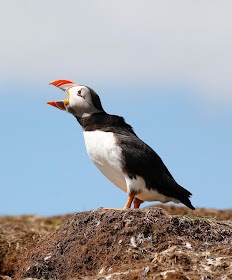
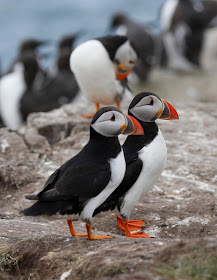






















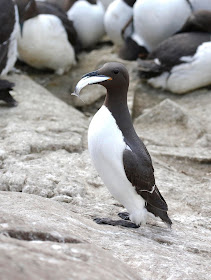






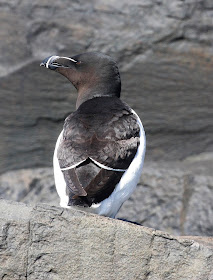


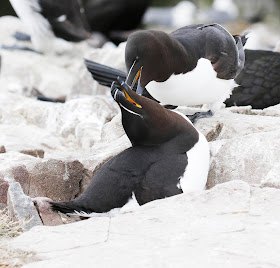












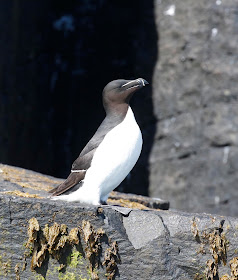


No comments:
Post a Comment